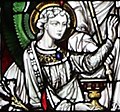Camael
Camael | |
|---|---|
 Sanctus Chamuel, stained-glass window at St Michael's Church, Brighton, England. | |
| Archangel | |
| Venerated in | Judaism, Anglicanism[citation needed] |
| Feast | 29 September |
| Attributes | Chalice, staff |
Camael, (Template:Lang-he Ḥammūʾēl, "God has warmed")[1] also spelled Chamuel, Khamuel, Camiel, Cameel and Camniel, is the archangel of strength, courage and war in Jewish and Christian angelology.
According to poet Gustav Davidson's popular work A Dictionary of Angels, Including the Fallen Angels (1967), he is known as one of the twelve Kabbalah angels, assigned to the sephira Gevurah, alongside the planet Mars. Camael's name is also included in Pseudo-Dionysius the Areopagite's 5th or 6th century Corpus Areopagiticum as one of the Seven Archangels along with Michael, Gabriel, Raphael, Uriel, Jophiel, and Zadkiel.[2] He is claimed to be the leader of the forces that expelled Adam and Eve from the Garden of Eden holding a flaming sword. However, in iconography he is often depicted holding a cup.
Camael was excluded from the Holy See's list of named angels mentioned in the Bible in the Directory of Public Piety (2002). A cult of veneration is thus excluded officially for Catholics, however it still enjoys wide widscale devotion in Folk Catholicism.[3]
In popular culture
- In Japanese light novel series Date a Live, Camael is the name of a spiritual weapon (referred to as Angels within the series), belonging to Kotori Itsuka. Camael is a giant burning halberd.
Gallery
-
The Principality Camael, engraving by Crispijn van de Passe, circa 1575. Biblioteca Nacional de España, Madrid.
-
St Chamuel in armour, detail of a stained-glass window at St Laurence Parish Church, Meriden.
-
Archangel Chamael, stained-glass window at the Main Protestant Chapel in Marine Corps Base Camp Lejeune, Jacksonville, North Carolina.
-
Archangel Chamuel, detail of the west window at St Martin in the Bull Ring, Birmingham, England.
-
The seven archangels window, the figure on the bottom centre represents Chamuel holding in his left hand a flag bearing his attribute (chalice), and in his right hand a staff. Stained glass at St Michael and All Angels Church, Warden, Northumberland.
References
- ^ "Strong's Hebrew Concordance - 2552. chamam".
- ^ Davidson, Gustav (1980). A Dictionary of Angels, Including the Fallen Angels. Free Press Publishing.
- ^ Vatican Bans Rogue Angels "Chapter six deals with angels, delivering a stinging rebuff to followers of Uriel, Jophiel, Chamuel and Zadkiel, who enjoy a burgeoning reputation in New Age religions but make no appearance in the New or Old Testament."
- ^ Furnival, William James (1904). Leadless Decorative Tiles, Faience, and Mosaic, Comprising Notes and Excerpts on the History, Materials, Manufacture & Use of Ornamental Flooring Tiles, Ceramic Mosaic, and Decorative Tiles and Faience. Moscow: Ripol Classic Publishing House. p. 525. ISBN 978-1-176-32563-0.
While on either hand are the archangels: Michael is a glorious figure in armour; Uriel holds the sun; Gabriel bears the lily of the Annunciation; Chemuel, the angel of the Sangreal, stands next him with the sacred cup; and Zophiel, to his left, holds the moon.
Further reading
- Bamberger, Bernard Jacob, (March 15, 2006). Fallen Angels: Soldiers of Satan's Realm. Jewish Publication Society of America. ISBN 0-8276-0797-0
- Briggs, Constance Victoria, 1997. The Encyclopedia of Angels : An A-to-Z Guide with Nearly 4,000 Entries. Plume. ISBN 0-452-27921-6.
- Bunson, Matthew, (1996). Angels A to Z : A Who's Who of the Heavenly Host. Three Rivers Press. ISBN 0-517-88537-9.
- Cruz, Joan C. 1999. Angels and Devils. Tan Books & Publishers. ISBN 0-89555-638-3.
- Davidson, Gustav (1967) A Dictionary of Angels: Including the Fallen Angels. Free Press. ISBN 978-0-02-907050-5
- Graham, Billy, 1994. Angels: God's Secret Agents. W Pub Group; Minibook edition. ISBN 0-8499-5074-0
- Guiley, Rosemary, 1996. Encyclopedia of Angels. ISBN 0-8160-2988-1
- Kreeft, Peter J. 1995. Angels and Demons: What Do We Really Know About Them? Ignatius Press. ISBN 0-89870-550-9
- Lewis, James R. (1995). Angels A to Z. Visible Ink Press. ISBN 0-7876-0652-9
- Melville, Francis, 2001. The Book of Angels: Turn to Your Angels for Guidance, Comfort, and Inspiration. Barron's Educational Series; 1st edition. ISBN 0-7641-5403-6
- Ronner, John, 1993. Know Your Angels: The Angel Almanac With Biographies of 100 Prominent Angels in Legend & Folklore-And Much More! Mamre Press. ISBN 0-932945-40-6.





![Mosaic in the semi-dome of St. Paul's Within the Walls in Rome, depicting Christ Enthroned in the Heavenly Jerusalem with the five archangels, from left: Uriel, Michael, Gabriel, Chemuel (holding a cup), and Zophiel.[4]](http://upload.wikimedia.org/wikipedia/commons/thumb/8/8e/Christ_Enthroned_in_the_Heavenly_Jerusalem%2C_St_Paul%27s.jpg/120px-Christ_Enthroned_in_the_Heavenly_Jerusalem%2C_St_Paul%27s.jpg)